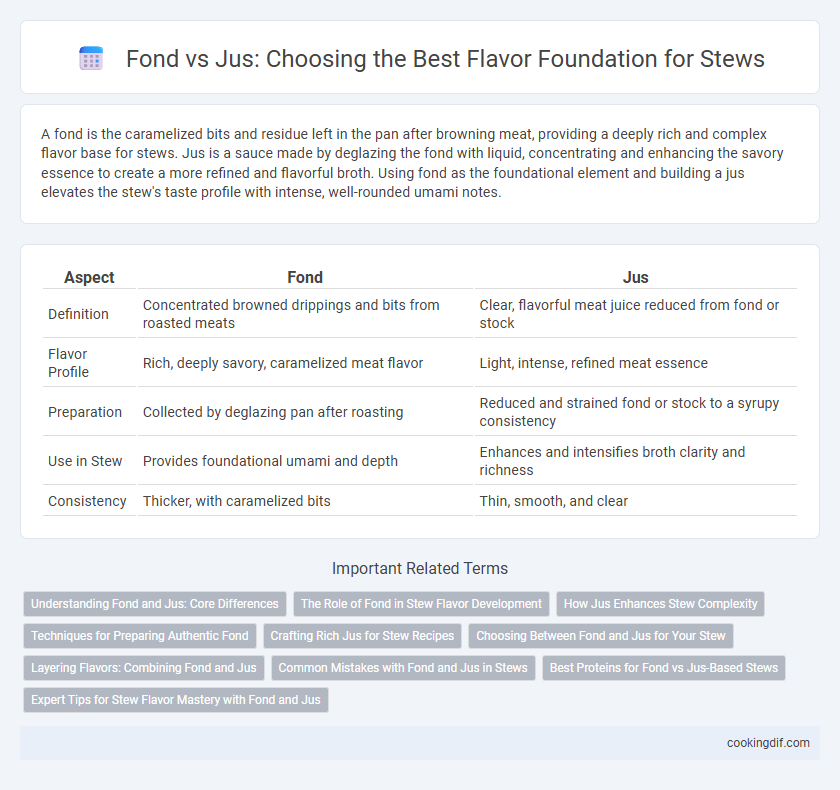A fond is the caramelized bits and residue left in the pan after browning meat, providing a deeply rich and complex flavor base for stews. Jus is a sauce made by deglazing the fond with liquid, concentrating and enhancing the savory essence to create a more refined and flavorful broth. Using fond as the foundational element and building a jus elevates the stew's taste profile with intense, well-rounded umami notes.
Table of Comparison
| Aspect | Fond | Jus |
|---|---|---|
| Definition | Concentrated browned drippings and bits from roasted meats | Clear, flavorful meat juice reduced from fond or stock |
| Flavor Profile | Rich, deeply savory, caramelized meat flavor | Light, intense, refined meat essence |
| Preparation | Collected by deglazing pan after roasting | Reduced and strained fond or stock to a syrupy consistency |
| Use in Stew | Provides foundational umami and depth | Enhances and intensifies broth clarity and richness |
| Consistency | Thicker, with caramelized bits | Thin, smooth, and clear |
Understanding Fond and Jus: Core Differences
Fond is the caramelized browned bits of meat and vegetables left in the pan after searing, providing a rich, concentrated base for sauces and stews. Jus is a light, flavorful sauce made by deglazing the fond with stock or wine, then reducing it to enhance the natural taste and moisture of the meat. Understanding these core differences allows chefs to manipulate texture and intensity, creating stews with layered, deep flavors.
The Role of Fond in Stew Flavor Development
Fond forms the crucial flavor foundation in stew by creating deep, caramelized notes from browned meat and vegetables. This residue deglazes into the cooking liquid, enriching the stew with complex savory layers and enhancing the Maillard reaction's impact. Unlike jus, which is a reduced, concentrated sauce, fond directly interacts with the stew's ingredients, anchoring its robust and savory profile.
How Jus Enhances Stew Complexity
Jus, made from richly reduced pan drippings and wine, intensifies stew complexity by adding a deep, savory concentration that transcends the simpler, sweeter base of fond. Its robust mineral and umami notes create layers of flavor, elevating the stew's overall profile with a silky, well-rounded finish. Incorporating jus transforms the stew into a gourmet dish by balancing rich meatiness with nuanced acidity and sweetness.
Techniques for Preparing Authentic Fond
Authentic fond preparation involves deglazing the browned bits stuck to the pan after searing meat, using techniques like slow simmering with wine, broth, or stock to dissolve caramelized proteins and enhance umami flavor. Properly rendering fond requires careful temperature control to avoid burning, ensuring a rich, concentrated base for sauces or stews. This foundational technique intensifies depth and complexity, distinguishing jus made from fond compared to simpler broths.
Crafting Rich Jus for Stew Recipes
Creating a rich jus for stew recipes involves slowly reducing browned meat drippings combined with aromatic vegetables and stock to intensify deep, savory flavors. Unlike fond, which primarily refers to the browned bits left in the pan after searing, jus is a refined sauce that balances these concentrated flavors with acidity and seasoning to enhance the stew's complexity. Mastering the technique of deglazing and simmering these elements results in a luxurious jus that forms an essential flavor foundation for slow-cooked stews.
Choosing Between Fond and Jus for Your Stew
Fond, the caramelized residue left from searing meat, provides a rich, deep flavor base essential for hearty stews, while jus, a naturally reduced meat juice, offers a lighter yet intensely concentrated essence. Selecting fond for your stew builds complex, robust taste profiles through deglazing techniques, whereas jus enhances the dish with purity and smoothness. Balancing these elements based on desired stew intensity and texture determines the optimal flavor foundation.
Layering Flavors: Combining Fond and Jus
Fond, the caramelized bits left in a pan after cooking, provides a deep, concentrated flavor base rich in umami compounds essential for stews. Jus, a refined, strained sauce made from the fond and reduced cooking liquids, adds a smooth, balanced taste with intensified savory notes. Combining fond and jus in stews enhances flavor layering by merging robust, complex undertones with a silky texture, creating a more dynamic and nuanced taste profile.
Common Mistakes with Fond and Jus in Stews
Fond often forms the rich flavor foundation of stews, but a common mistake is overcooking it, which leads to bitterness instead of depth. Jus, derived from natural meat juices, can be underutilized when diluted excessively, resulting in a weak, diluted stew base. Balancing the intensity of fond and maintaining the concentration of jus is crucial for a robust, well-rounded stew flavor.
Best Proteins for Fond vs Jus-Based Stews
Fond, the caramelized bits left in the pan after searing proteins like beef or lamb, provides a robust, deep flavor ideal for hearty stews. Jus, a lighter, often strained sauce derived from the natural juices of delicate proteins such as chicken or veal, delivers a more subtle and refined taste. For the richest flavor foundation, use fond with dense, flavorful proteins like short ribs or chuck roast, while jus complements tender cuts like chicken thighs or veal shanks to highlight the nuanced essence of the stew.
Expert Tips for Stew Flavor Mastery with Fond and Jus
Expert tips for stew flavor mastery emphasize building a rich foundation using fond and jus; fond, the caramelized brown bits left from searing meat, adds deep, savory complexity, while jus, a thin, flavorful sauce made from natural meat juices, enhances moisture and intensity. To maximize flavor, deglaze the pan with wine or broth to lift the fond and incorporate it into the stew base, creating a robust, layered taste. Slowly simmering with jus ensures the stew remains succulent, balancing richness and tenderness for gourmet-quality results.
Fond vs Jus for flavor foundation Infographic

 cookingdif.com
cookingdif.com